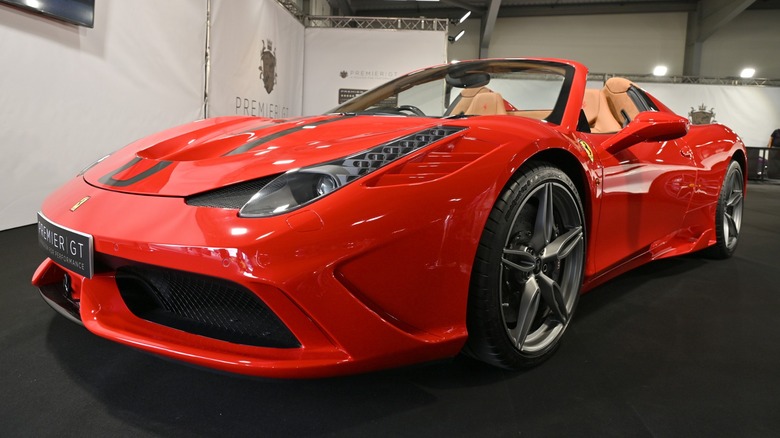The Engine Design That Makes Ferraris Sound So Good
Ferrari has put a number of engines in its cars over the years. However, it's the automaker's flagship V12 engine design that springs to mind when someone asks what makes them sound so good. The Ferrari V12 sound even made it into "Gone in 60 Seconds," when lead characters Randall "Memphis" Raines and Otto Halliwell reminisce over a recording played on an old tape player in Otto's garage. The older Otto is pleased when his protege, Memphis, correctly identifies the Ferrari engine as a V12.
Ferrari's original Colombo V12, designed by Gioacchino Colombo, debuted in 1947 in the 125 S with a total displacement of 1.5 liters, the smallest V12 ever made, according to "The Official Ferrari Magazine." Ferrari continued using the Colombo V12 until 1989, with its largest displacement version topping out at 4.9L.
The 1962 Ferrari 250 GTO is just one example of the most expensive cars powered by V12 engines, with its 3.0L Colombo V12-produced 300 horsepower. However, it was a 350-hp 4.4L quad-cam Colombo V12 in a Ferrari 365 GTB/4 credited with the sweet exhaust notes played in Otto's garage.
Why does the Ferrari V12 sound so good?
As a lifelong gearhead, I can relate to Otto and Memphis in their joy of listening to engine sounds. In the words of Steve Earl's Copperhead Road, "I still remember that rumblin' sound" from my days of working on the stock cars my family entered in local races.
While small-block Chevy engines sound good, it's a different note compared to the Ferrari engine. Part of the difference is the crankshaft design found at the heart of each engine. The older Chevy small block uses a cross-plane crankshaft as opposed to the flat-plane design found in the Ferrari V12. Ferrari V12 crankshafts have six rod journals which allow two connecting rods to each. The resulting uneven firing order results in overlapping power strokes and provides smooth linear power throughout its rpm range and Ferrari's distinctive wail at higher revs.
While the Colombo V12 gets credit for the most distinctive Ferrari sounds, Ferrari's V8 engines sound good too. Let's explore some other engine options you might find in your next (or first) Ferrari.
A few V8 Ferrari engines
Ferrari was all-in on the V12 engine until the Italian automaker introduced the V8-powered Ferrari 308 GTB in 1975. However, the 3.0L Ferrari V8 had already been in use, transversely mounted in the Dino 308 GT4 since 1973. The Dino lineup, built by Ferrari, was named after Enzo Ferrari's late son Alfredo, who was known as Dino to his friends and family. Ferrari's Dino brand was already well-known among F1 racers and connoisseurs of V6-powered Italian sports cars.
Ferrari went on to build an impressive assortment of V8 engines with sweet sounds of their own. The twin-turbocharged 2.9-liter V8 found in the Ferrari F40 is impressive due to the F40's lightweight. While the F40 was essentially a 470-horsepower go-kart, its turbocharged induction took a visceral element from the V8 unless you're a fan of the sound made when turbos spool up.
A modern member of the Ferrari V8 family, the 2023 Portofino M also features a twin-turbocharged flat-plane crank design. The 3.8L V8 produces 612 horsepower and, perhaps most importantly, an exhaust note worthy of the Prancing Horse logo by removing two mufflers from the rear of the exhaust system.
The 4.5L V8 found in the Ferrari 458 Speciale could be the crown jewel of the automaker's naturally aspirated V8 endeavors. The engine makes 597 horsepower at 9,000 rpm. Car and Driver tells us that Chevrolet went so far as tearing into the 458's engine while using the Italian supercar as a benchmark while developing its mid-engine Z06 Corvette. There's no denying the 458 Speciale V8 sounds amazing, a trait it shares with the Z06 Corvette.


